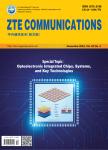MAC Layer Resource Allocation for Wireless Body Area Networks
MAC Layer Resource Allocation for Wireless Body Area Networks作者机构:Department of Electrical and Computer Engineering University of Waterloo School of Information Technology Deakin University Department of Electronic Engineering Shanghai Jiao Tong University
出 版 物:《ZTE Communications》 (中兴通讯技术(英文版))
年 卷 期:2014年第12卷第3期
页 面:13-21页
学科分类:080904[工学-电磁场与微波技术] 0810[工学-信息与通信工程] 0809[工学-电子科学与技术(可授工学、理学学位)] 08[工学] 080402[工学-测试计量技术及仪器] 0804[工学-仪器科学与技术] 081001[工学-通信与信息系统]
基 金:supported by a research grant from the Natural Science and Engineering Research Council(NSERC)under grant No.CRDPJ 419147-11 Care In Motion Inc.,Canada
主 题:medium access control (MAC) wireless body area networks (WBANs) resource allocation interference mitigation partially observable optimization
摘 要:Wireless body area networks (WBANs) can provide low-cost, timely healthcare services and are expected to be widely used for e-healthcare in hospitals. In a hospital, space is often limited and multiple WBANs have to coexist in an area and share the same channel in order to provide healthcare services to different patients. This causes severe interference between WBANs that could significantly reduce the network throughput and increase the amount of power consumed by sensors placed on the body. There-fore, an efficient channel-resource allocation scheme in the medium access control (MAC) layer is crucial. In this paper, we devel-op a centralized MAC layer resource allocation scheme for a WBAN. We focus on mitigating the interference between WBANs and reducing the power consumed by sensors. Channel and buffer state are reported by smartphones deployed in each WBAN, and channel access allocation is performed by a central controller to maximize network throughput. Sensors have strict limitations in terms of energy consumption and computing capability and cannot provide all the necessary information for channel allocation in a timely manner. This deteriorates network performance. We exploit the temporal correlation of the body area channel in order to minimize the number of channel state reports necessary. We view the network design as a partly observable optimization prob-lem and develop a myopic policy, which we then simulate in Matlab.



